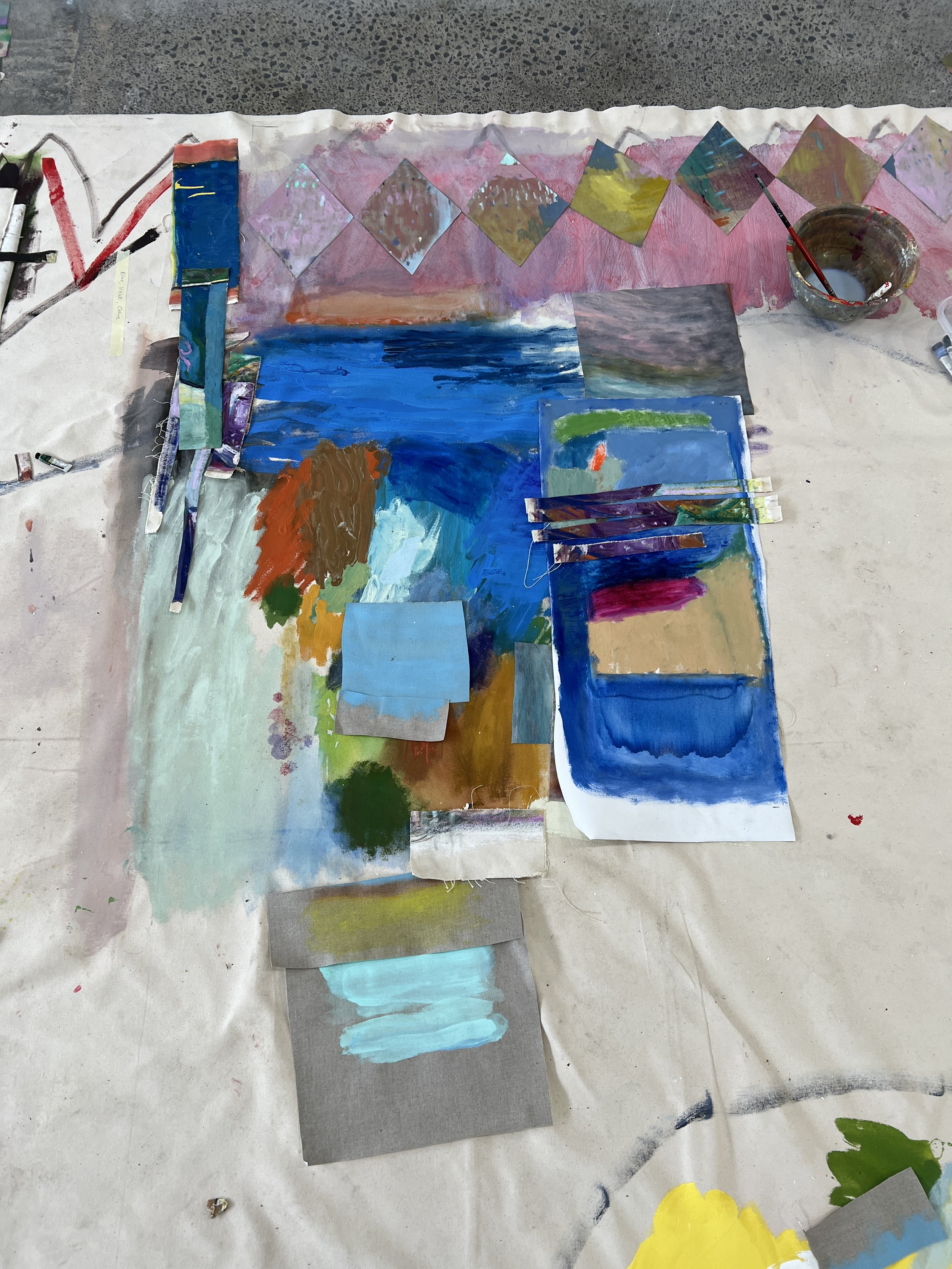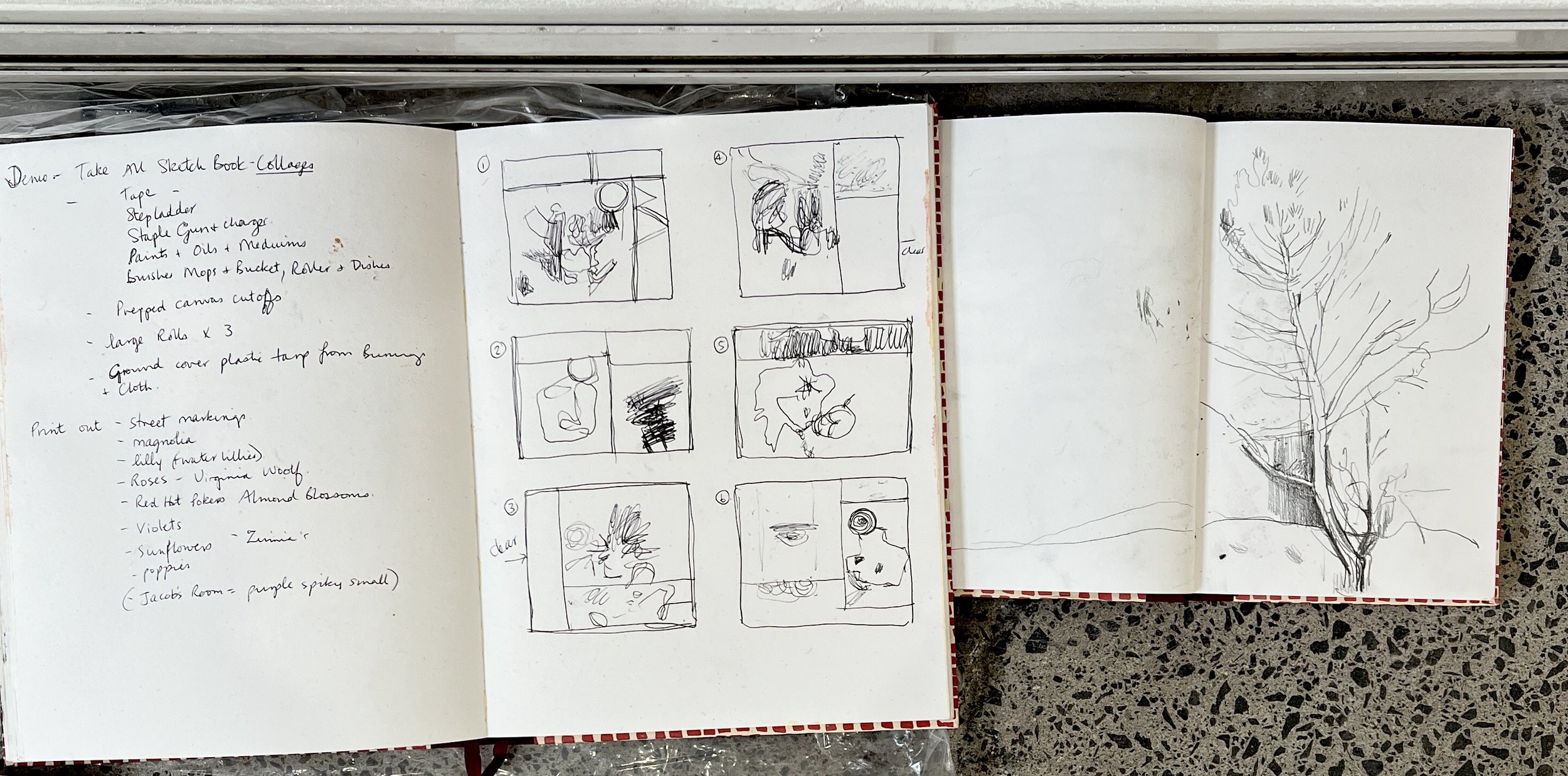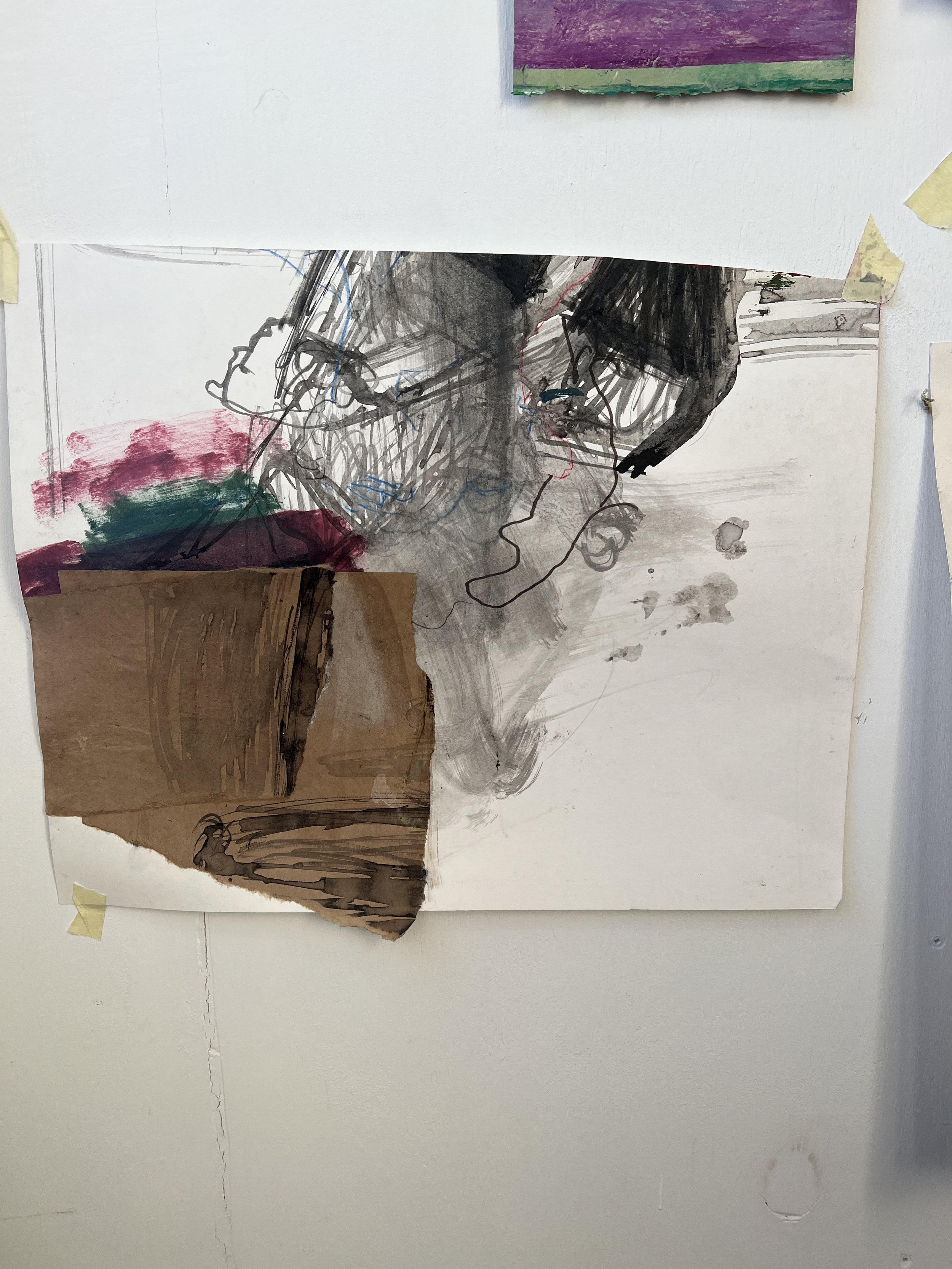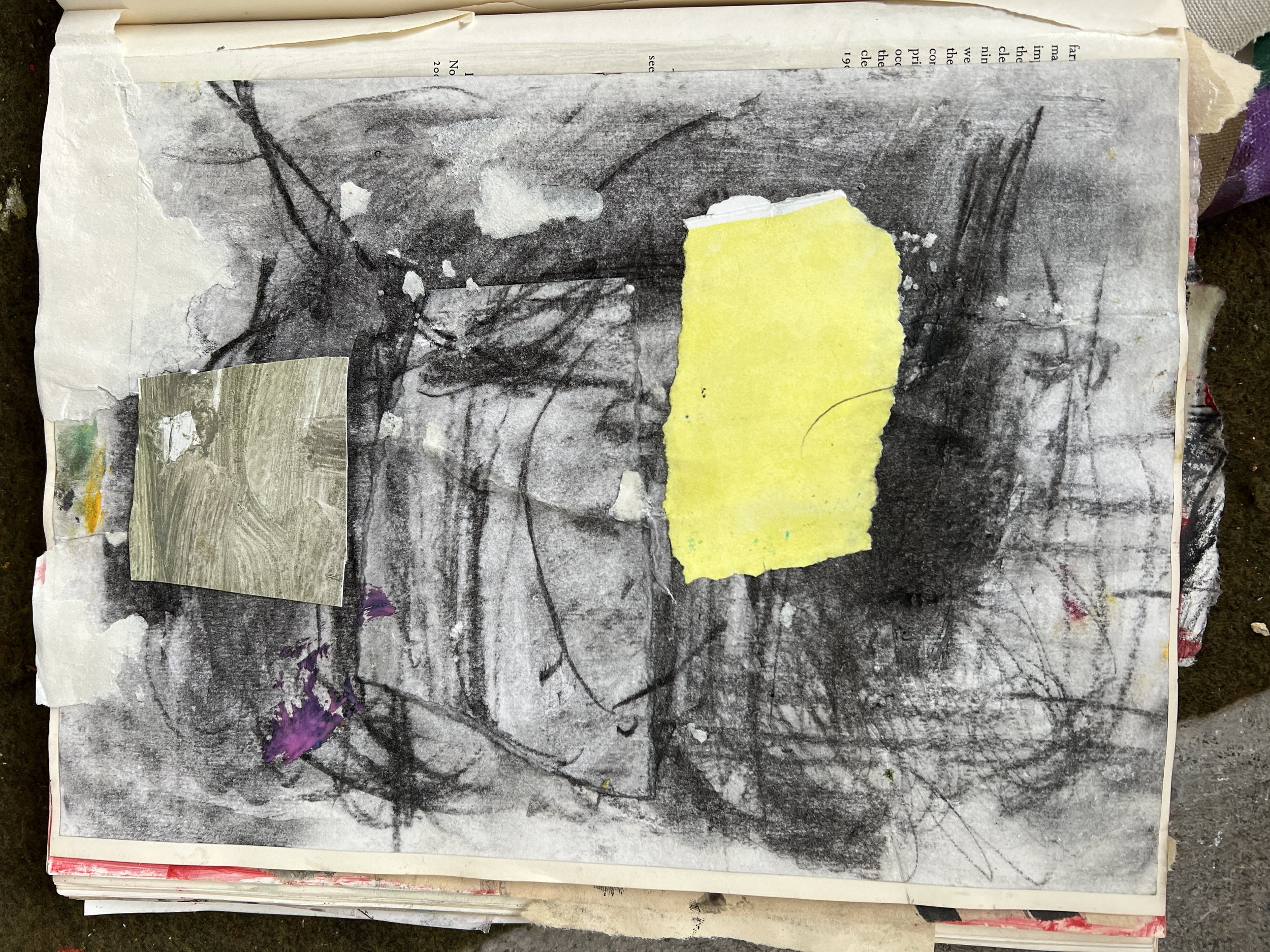Working at Demo
My aim for this week is to work purposefully on the floor, using different paints, tools, and methods from my usual wall or easel approach. To further detach from habitual patterns and processes, I will mostly use my non-dominant hand. I am using quick drying acrylic and house paint instead of oil paints, and utilizing long sticks, brushes, cloth, and hands.
Figure 1. Sally Barron, Beginning to Mark Out Large Canvas, 2024, house paint and acrylic on canvas, 3m x 5m.
On top of one large canvas I have been cutting up old canvases and scattering grid systems around 4-5 clusters of compositions, each with a different colour scheme, (fig 1).
These clusters will be separated from the canvas by cutting later in the week and then sewn together with blank or collaged canvas strips. Additionally, I am gluing parts of previous works onto the new compositions. Essentially, this large work is a collage that will become 4-5 separate collage/paintings, (fig 2-7).
Fig 2
Fig 3
Fig 4
simultaneously working on smaller paper collages and sketchbooks to try out new ideas and further existing compositions
Fig 5
Fig 6
Fig 7
Editing from my April Seminar postcard collages I selected 7 to refer to in Demo, chosen for their formal and structural qualities as well as strong colour use and texture (fig 8)
Fig 8, Postcards from the edge 1-7
Oil and pencil on card and foam
Influences, The Idea of Collage and the Pastoral
Inspired in particular by the patterning effects of the Nabis group and their interpretations of parks, and overlaid with a modernist sensibiity with regards to layered structures, I am mixing these influences with my own impressions of Auckland parks. This approach is reminiscent of artists like Lee Krasner, (fig 9 & 10) who reassembled pieces of previous works into new collages, and David Hockney, (fig 11) who explored different perspectives and techniques in his photo collages and paintings. Additionally, Sterling Ruby's innovative use of mixed media and unconventional materials to create complex, layered compositions also informs my work (fig 12).
Lee Krasner
The pastoral may be defined as a symbol of a simpler, rural life contrasting with the complexities of modernity. Krasner's collages engage in similar contrasts, blending organic shapes with geometric elements and playing with textures and colours. Compositions, like "Blue Level" (fig 9) reflect pastoral themes through their iconography and methods. Critic Bryan Robertson describes her art as "pastoral and bucolic," highlighting her connection with nature. 1 Writer David Halperin suggests also that ‘the pastoral's’ significance lies in its use of oppositions, extending beyond the rural-urban divide to encompass various scales, forms, and identities for allegorical contrast. 2
Fig 9, Lee Krasner.
Blue Level, 1955.
Oil, paper, and burlap collage on canvas.
82 1/4 x 58 inches (208.9 x 147.3 cm).
Fig 10, Lee Krasner.
Bald Eagle, 1955.
Oil, paper, and canvas collage on linen.
77 x 51 1/2 inches (195.6 x 130.8 cm).
David Hockney
Slow Rise (fig 11), part of Hockney's ongoing exploration of California's geography, reflects his fascination with Picasso's cubist experiments. Employing a cubist approach, with abstract shapes and textures, Hockney's theatrical set design background infuses the piece with artificiality and imaginative landscape. The lithographic and silk-screened techniques enhance its surface. The piece features visual textures hinting at mechanical production methods, and shows Hockney's experimentation with new tools and materials. 2
Fig 11, Hockney, David. Slow Rise, 1994. 37 color lithograph/screenprint, 32/68. Gift of Josephine L. Ferguson and Byron L. Ferguson. Brauer Museum of Art: 2000:09.
Sterling Ruby
A related suite of small collages from the ongoing series DRFTRS (2013–) (a shortened form of "drifter") (fig 12), includes watercolor paintings of rainbows interspersed with photographic images of bones taken from archaeological magazines, posing a poignant question: What is a rainbow if nothing remains alive to see it? Ruby has referred to the medium of collage as an “illicit merger,” suggesting both conceptual and technical transgression. 3
Fig 12, Sterling Ruby. Sterling Ruby Drifts (7774), 2021. Collage, paint, and glue on paper, 8 1/2 x 11 inches (21.6 x 27.9 cm).
In my own work I often sketch or paint from life before studio work (fig 13)
Fig. 13. Sally Barron, hill, 2023. Oil on canvas, 400 x 450 mm.
Embedded in a ‘failed’ work can be the next idea. For me an attachment to the observed world is essential to abstracting it, just as manifesting an idealized location is essential to crafting an artificial identity. 4
Sketchbooks 2024
Sketchbooks 2024
Collage Ideas
Overlapping: Touching or overlapping elements add depth, layers, and dimension to create a cohesive piece.
Suggestion: Add a single floating element to contrast with overlapping elements.
Outlining: Outlines ground elements into the background while making them stand out.
Suggestion: Use scratches, broken lines, dots, letters, words, or stitches for outlining.
Repeating: Repeating elements, such as shapes, colors, symbols, or emotions, enhances cohesion.
Suggestion: Repeat elements an odd number of times; three is often effective.
Contrasting: Incorporating dissimilar elements (color, size, texture, etc.) creates interest and surprise.
Suggestion: Adding seemingly mismatched elements can lead to unexpected creativity.
Guiding: Element placement guides the viewer’s eye and can support the artwork's message.
Suggestion: Use shapes (circles, lines, arrows) and directional text to direct the viewer’s gaze.
Further drawings and collages become simpler and larger.
Some collages are starting to work as stand alone pieces. The sense of movement and weather is what I would like to encourage in my larger painting.
Studio wall July
Still developing my ‘books’ of impressions
Footnotes
Daniel Haxall, "Lee Krasner’s Pastoral Vision: Collage and the Nature of Order," Woman’s Art Journal 28, no. 2 (Fall/Winter 2007): 20, Old City Publishing, Inc.
David M. Halperin, Before Pastoral: Theocritus and the Ancient Tradition of Bucolic Poetry (New Haven: Yale University Press, 1983), https://doi.org/10.2307/j.ctt211qx2w, accessed June 4, 2024.
Gregg Hertzlieb, "David Hockney: Slow Rise," Valparaiso Poetry Review: Contemporary Poetry and Poetics 5, no. 1 (Fall/Winter 2007), accessed May 26, 2024, https://www.valpo.edu/vpr/hertzliebhockney.html.
Sterling Ruby, Future Present, November 20, 2021–February 19, 2022, Rome, Gagosian, accessed May 26, 2024.
Grace Wolfe, "Of Homespun Opulence: An Analysis of Jane Freilicher's Pastoral Abstraction in Parts of a World," Anthós 10, no. 1 (2021): 12, https://doi.org/10.15760/anthos.2021.10.1.3, accessed May 27, 2024.

















